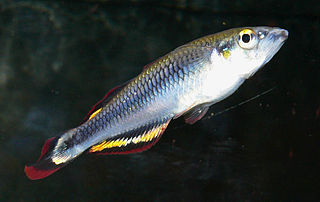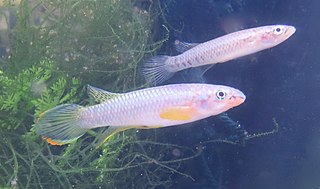
Aphanomyces is a genus of water moulds. As of 2003 there were about 45 described species. Many of these water moulds are known as economically important pathogens of species of plants and animals, including fish, crustaceans, and agricultural crop plants. Aphanomyces water moulds are "one of the most important yield-limiting factors in production of legumes and sugarbeet."
Edaphodon was a prehistoric chimaeriform fish genus of the family Callorhinchidae. So, Edaphodon was a type of rabbitfish, a cartilaginous fish related to sharks and rays. Edaphodon has under 15 known species, all of which are extinct. This genus appeared in Aptian age and vanished in Pliocene. It was most prominent during the Late Cretaceous. All Edaphodon species were situated in the Northern Hemisphere, apart from E. kawai, which was recently discovered in the Chatham Islands near New Zealand. This shows the range of Edaphodon reached further than was previously thought.

Pachypanchax playfairii, the golden panchax, is a species of Aplocheilid killifish, the only species of freshwater fish endemic to the Seychelles, a group of islands in the Indian Ocean directly east of Tanzania, and the only member of its genus found outside of Madagascar. Within the Seychelles it is found only on the granitic islands. Here it occurs in small freshwater and brackish water streams, feeding on worms, crustaceans, insects and fish. An egg scatterer, the golden panchax breeds amongst floating water plants. This species is unusual in that the scales of the male become lifted during the breeding season, giving the skin a rough appearance. Unlike the true annual killifish, they live as long as similar fishes, a few years, 3 years is not uncommon 5 is unknown.

Bedotia is a genus of the family Bedotiidae of fishes endemic to Madagascar.

Pachypanchax omalonotus, the powder-blue panchax, is a species of Aplocheilid killifish endemic to Madagascar where it is found on the island of Nosy Be and in the Sambirano River basin and adjacent streams on the mainland. Its natural habitat is rivers.

Pachypanchax sakaramyi is a species of Aplocheilid killifish endemic to Madagascar where it is only known from Sakaramy and Antongombato Rivers with reports that it is found in several crater lakes. Its natural habitats are rivers and freshwater lakes. It is threatened by habitat loss and invasive species.
Pachypanchax sparksorum is a species of Aplocheilid killifish endemic to Madagascar where it is found in the Anjingo River and streams feeding into the Ankofia River. Its natural habitat is rivers. The specific name of this fish honours the ichthyologist John S. Sparks of the United States National Museum and his wife Karen Riseng Sparks, they collected many of the type series.
Pachypanchax arnoulti is a species of aplocheilid killifish endemic to Madagascar. Its natural habitat is rivers and lakes. It is threatened by habitat loss and invasive species. The specific name of this fish honours the French ichthyologist and herpetologist Jacques Arnoult (1914-1995) in recognition of his contributions to the knowledge of Madagascar's fish fauna. It was described by Paul V. Loiselle in 2006 with the type locality given as "Swamp draining into tributary stream of Ikopa River, flowing parallel to RN-4 at Antanimbray village, 17°10'79"S, 46°50'97"E, Betsiboka River drainage, Madagascar, elevation 246 meters".
Pachypanchax sp. nov. 'Sofia' is a species of fish in the family Aplocheilidae. It is endemic to Madagascar. Its natural habitat is rivers.
Pachypanchax sp. nov. 'Tsiribihina' is a species of fish in the family Aplocheilidae. It is endemic to Madagascar. Its natural habitat is rivers.
Pachypanchax varatraza is a species of Aplocheilid killifish endemic to Madagascar where it is found in the Menambery, Fanambana and Ampanobe rivers. Its natural habitat is streams and pools. It is threatened by invasive species.
Paratilapia sp. nov. 'Lac Ihotry' is a formally undescribed species of fish in the family Cichlidae. It is endemic to Madagascar. Its natural habitats are rivers and freshwater lakes. It is threatened by habitat loss.
Ptychochromis loisellei is a species of cichlid from the Mahanara River basin north of Sambava in northeastern Madagascar. It remains common within its small range, but it is threatened by habitat loss and introduced species. It reaches about 11.9 centimetres (4.7 in). The similar named Paretroplus loisellei is also restricted to the Mahanara River basin. The specific name honours Paul V. Loiselle, Emeritus Curator of Freshwater Fishes at the New York Aquarium and a researcher in, and campaigner for the conservation of, the freshwater fish of Madagascar.

Ptychochromoides is a genus of cichlids endemic to Madagascar. Of the three described species, two are critically endangered and one was considered extinct until rediscovered in late 2010.

Platichthys is a genus of flatfish native to the North Pacific and North Atlantic oceans. Despite being in the family Pleuronectidae, all three species in the genus Platichthys are often "lefteyed", i.e. they lie on the sea bottom on their right side, with both eyes on the left side.
Paretroplus loisellei is a vulnerable species of cichlid fish from the Mahanara River basin north of Sambava in northeastern Madagascar. Until its scientific description in 2011, this population was usually referred to as Paretroplus sp. nov. "Ventitry" or included in P. damii, which it resembles. It reaches about 15 centimetres (5.9 in) in length, and is threatened by habitat loss and introduced species. The similar named Ptychochromis loisellei is also restricted to the Mahanara River basin. The specific name honours Paul V. Loiselle, Emeritus Curator of Freshwater Fishes at the New York Aquarium and a researcher in, and campaigner for the conservation of, the freshwater fish of Madagascar.
Epiplatys sexfasciatus or six-barred panchax is a species of fish in the family Aplocheilidae that can be found in West and Central Africa. The fish is a timid surface dwelling predator. The six-barred panchax is up to 10 cm (4 in) long and closely resembles Epiplatys longiventralis.

Epiplatys is a genus of African rivuline in the family Nothobranchiidae endemic to Africa as the name indicates. Several of these species are popular aquarium fish.
Pronothobranchius is a genus of aplocheilid fish native to western Africa.
Pachypanchax patriciae is a species of killifish from the family Aplocheilidae. It is endemic to Madagascar where it occurs in the basins of the Mananjeba, Mahavavy du Nord, Ifasy, Manehoko and Ampandra rivers in the north west of the island. The specific name of this fish honours the Malagasy conservationist Patricia Yazgi (1946-2006), who ran the charity Friends of Fishes and who supported efforts to document and conserve the freshwater fish fauna of Madagascar. This species appears to feed mainly the adults and nymphs of terrestrial insects and on the larvae of aquatic insects and its most important predators are fish-eating birds and dragonfly nymphs. It may, however, be threatened by introduced alien fishes in some areas.








